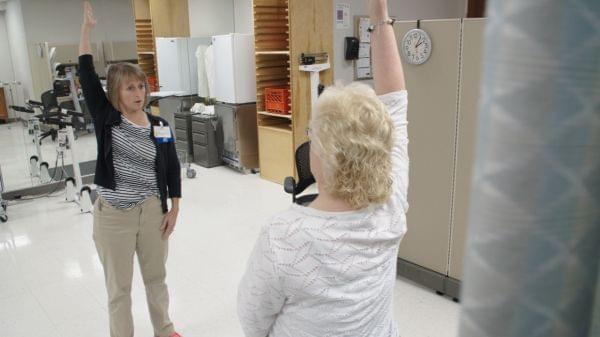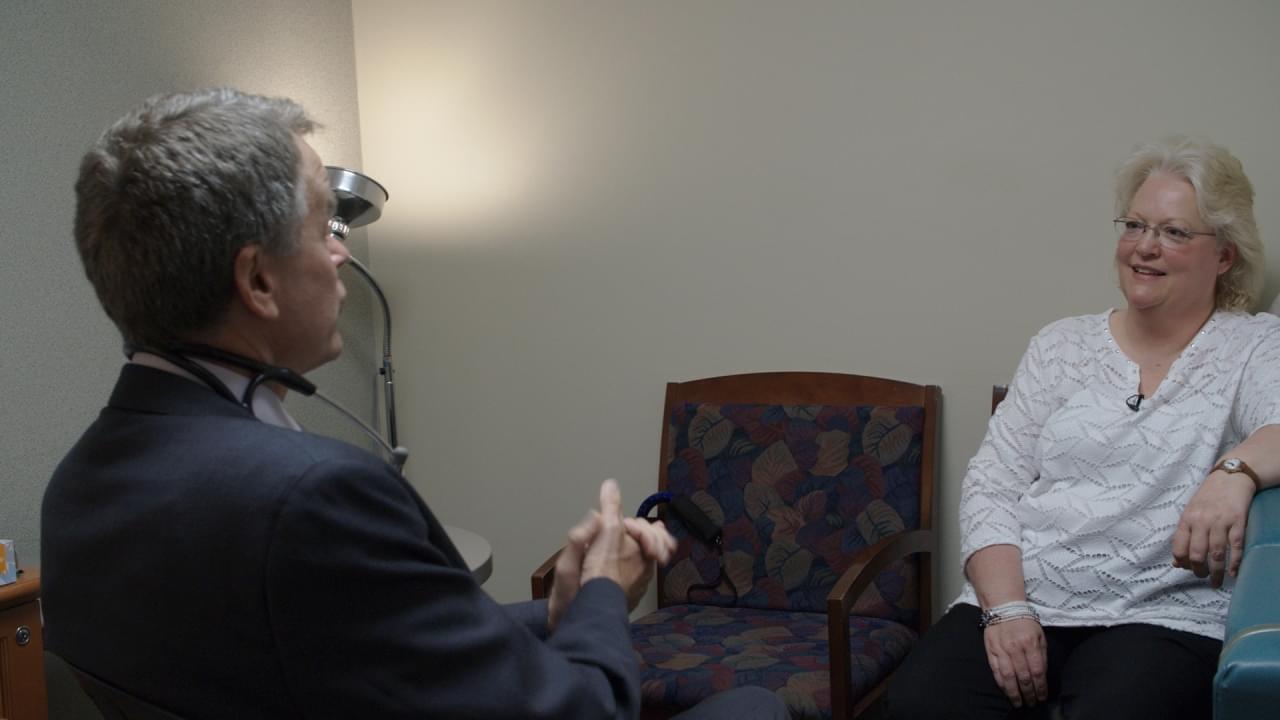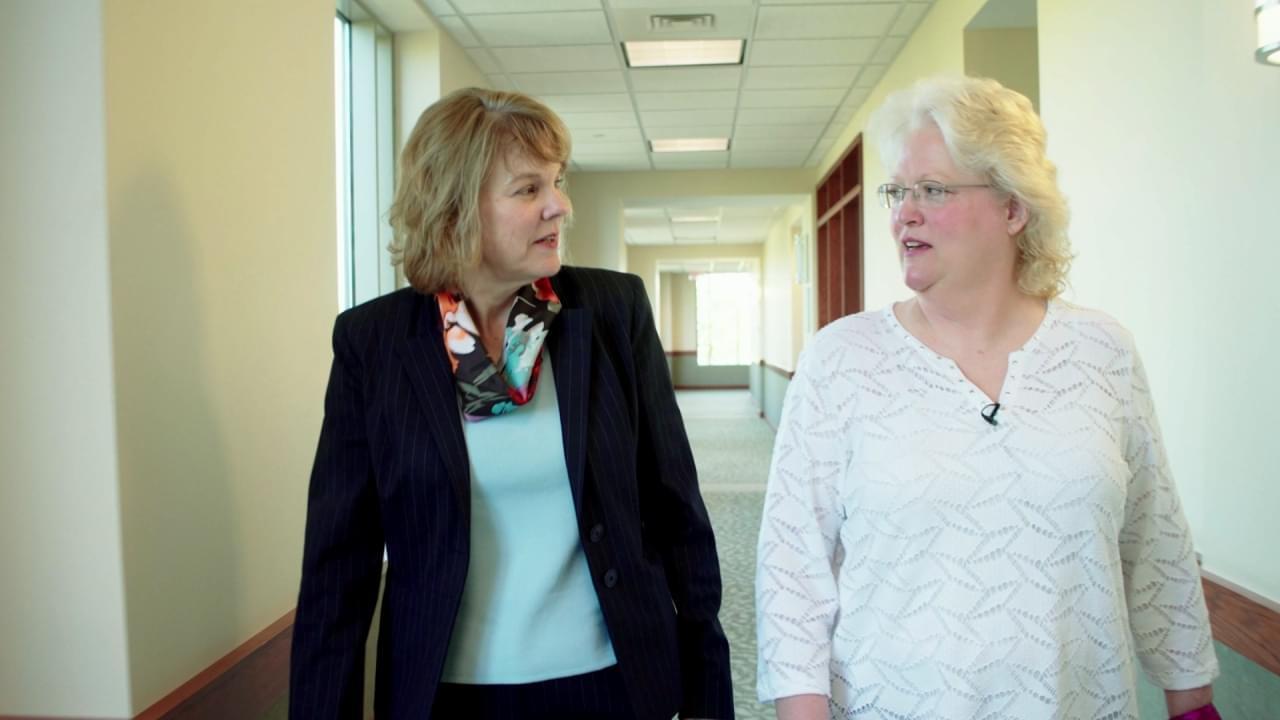The Best Medicine For Chronic Pain Is Not A Drug, Experts Say

Physical therapist Ingrid Peele coaches Kim Brown through strengthening exercises to help her with her chronic pain, at the OSF Central Illinois Pain Center in Peoria. Kyle Travers/WFYI
It took several months and a team of half a dozen doctors, nurses and therapists to help Kim Brown taper off the opioid painkillers she’d been on for two years.
Brown had been taking the pills since an injury in 2010. It wasn’t until she met Dr. Dennis McManus, a neurologist who specializes in non-pharmacological approaches to pain management that she learned she had some control over her pain.
“That’s when life changed,” she said.
During a 12-week program of appointments at McManus’ clinic in Peoria, Illinois, Brown learned new ways to prevent and cope with pain, as she gradually reduced her opioid doses.
Roughly a third of all Americans live with chronic pain, and many of them become dependent on opioids prescribed to treat it. But there’s a growing consensus among pain experts that a low-tech approach focused on lifestyle changes can be more effective.
This kind of treatment can be more expensive - and less convenient - than a bottle of pills. But pain experts say it can save money over the long term by helping patients get off addictive medications and improving their quality of life.

Kim Brown had been taking prescribed opioids since an injury in 2010. It wasn’t until she met Dr. Dennis McManus, a neurologist who specializes in non-pharmacological approaches to pain management, that she learned she how to manage her pain without the medications.
“It’s important to remember that the main treatments that are recommended for these pain conditions are not medication treatments,” said Dr. Erin Krebs a primary care physician and researcher at the Minneapolis VA Health Care System.
Recently, Krebs published the first long-term randomized trial of opioids for treating chronic back pain and arthritis, and found that opioids are no better than non-opioid medications. She said drugs of any kind are the lesser choice.
The gold standard for treatment, she said, is a combination of things like exercise, rehabilitation therapies, yoga, and cognitive behavioral therapies.
This approach is consistent with the most recent guidelines from the Centers for Disease Control and Prevention for prescribing opioids for chronic pain. But it’s still uncommon.
Brown’s painkiller use started after she blew out a disc in her back.
“It was the simplest thing. I picked up a bag of garbage with my right hand, and I immediately knew something was wrong,” Brown said.
She was put on opioids, like so many others who report to the doctor with pain. In a single year, health care providers write enough opioid prescriptions for every adult in the U.S. to have a bottle of pills.
Each time Brown came back, still in pain, another opioid was added to the list. She was eventually taking four different drugs - Percoset, Vicodin, morphine and Dilaudid - popping pills every two hours.
“I was just drugged constantly,” Brown said. “And even with that, it didn’t take care of the pain.”
Not only did the drugs not help with the pain, the side effects made it worse. Brown had such severe abdominal pain from constipation she could hardly walk.
“It kills your life. It totally robs you of every aspect,” she said. “I couldn’t do anything because of the pain. But I couldn’t do anything because of the pain meds. And I couldn’t talk to anyone about it, because it was so embarrassing.”
Brown tried to quit on her own. But after nine days of nausea and fainting from withdrawal, she was back on the medications.
“I finally went to my family doctor and said, ‘I need help, I’ve got to get off this stuff. I can’t live like this anymore,’” she said.

At the OSF Central Illinois Pain Center in Peoria, Kim Brown participated in a multidisciplinary treatment program that included cognitive behavioral therapy with psychologist Lisa McClure, who helped her address the psychological issues that can accompany pain.
That’s when she was referred to McManus, director of the OSF Central Illinois Pain Center in Peoria.
McManus specializes in helping chronic pain sufferers like Brown get off opioids.
“From my perspective, if you stabilize the dose and slowly taper off, these patients do remarkably well,” he said.
At the center, a team of providers work together to help patients make lifestyle changes that reduce pain during everyday activities.
The approach includes a combination of physical and occupational therapy, massage, and nutrition counseling. Patients also participate in cognitive behavioral therapy to address the psychological issues that often accompany pain - such as overcoming fears of letting go of medications they’ve become dependent on. A nurse coordinator oversees all the moving parts and does follow-up assessments after the program is completed.
At the clinic, Brown met occupational therapist Gabe Stickling, who taught her things like how to properly lift heavy objects and how to safely keep exercising even when she feels a twinge of pain.
Stickling said people with chronic pain often avoid physical activity “because they’re afraid they’re going to injure themselves or damage their bodies.” But inactivity can make the pain worse.
McManus said this approach is not for everyone: Real change takes commitment from patients.
“Most people just really want to have the magic wand that will get them all better,” he said. “And I’m just trying to say - I don’t have a magic wand, but I might have a way out of this jungle that you’re in.”
And because non-drug treatments are hands-on and time-intensive, it can be hard to find a clinic that offers them, and to get insurance to cover them.
McManus said he thinks the issue boils down to money.
“It’s a lot cheaper to put someone on a chronic opioid,” he said. “That’s cheaper than having a whole bunch of people working on you.”
But Krebs is hopeful things will change, as communities see the hidden costs of opioids.
“It’s not just the price of the pills,” she said. “It’s also the price of the consequences when you over-rely on something.”
Over the course of several months with McManus’ team, Brown tapered off opioids. She said she’s thankful this approach helped her get her life back, even though it’s a different life than before her injury.
“There’s no such thing as a pain-free day for me,” Brown said. “It never, never fully goes away.”
She’s just learned how to manage life with it.
This story was produced by Side Effects Public Media, a news collaborative covering public health.
Follow Christine on Twitter: @CTHerman
Links
- Opioid Overdoses May Be Seriously Undercounted
- As States Embrace Cannabis As Opioid Alternative, Science Lags Behind Policy
- Illinois Opioid Addiction Helpline Sees Influx Of Calls After Launch
- Opioid Task Force Continues To Search For Tools To Reduce Deaths In Illinois
- Opioid Epidemic Hits Illinois Hardest In The Southern Region

